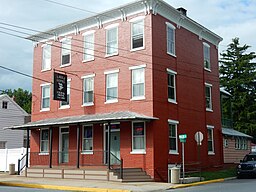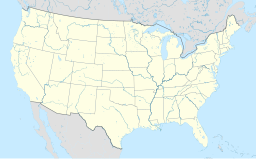Bernville, Pennsylvania
| Bernville, Pennsylvania | |
| Borough | |
|
Eagle Hotel
|
|
| Country | United States |
|---|---|
| State | Pennsylvania |
| County | Berks |
| School District | Tulpehocken |
| Elevation | 328 ft (100.0 m) |
| Coordinates | 40°26′01″N 76°06′40″W / 40.43361°N 76.11111°WCoordinates: 40°26′01″N 76°06′40″W / 40.43361°N 76.11111°W |
| Area | 1.1 km2 (0.4 sq mi) |
| - land | 1.1 km2 (0 sq mi) |
| - water | 0.0 km2 (0 sq mi) |
| Population | 955 (2010) |
| Density | 853.2/km2 (2,209.8/sq mi) |
| Borough | 1851 |
| Mayor | Gail Stoudt |
| Timezone | EST (UTC-5) |
| - summer (DST) | EDT (UTC-4) |
| ZIP Code | 19506 |
| Area code | 610 Exchange: 488 |
Bernville is a borough in Berks County, Pennsylvania, United States. The population was 955 at the 2010 census. Bernville is bordered by Penn Township to the north, east, and south and by Jefferson Township to the west.
Before European settlers arrived in the Tulpehocken Creek valley, the area was inhabited by the Lenape people. In 1723, thirty-three Palatine families from Schoharie, New York, moved to the confluences of the Tulpehocken and Northkill Creeks. By 1735, a saw and grist mill was located three and a half miles up the Tulpehocken river from Bernville.
In 1737, Stephanus Umbenhauer immigrated from Bern, Switzerland, and purchased 220 acres (0.89 km2) from Thomas Penn. In 1819, Stephanus' grandson, Johann Thomas Umbenhauer, set aside 46 acres (190,000 m2) to be divided into 62 lots. On 24 August 1819, Peter Bennethum bought the first six lots. In January 1820, the town was named Bernville after Stephanus' birthplace. The first house was built by Philip Filbert in 1820. In 1828, the Union Canal was completed, connecting the Susquehanna and Schuylkill rivers. Union Canal guard lock #36 and Lock #36 with a lift of 5.0 feet (1.5 m) is located at the southwest corner of Bernville, near where Northkill Creek empties into Tulpehocken Creek. An historic marker on Route 183 states: "The canal, at this point, followed the north bank of the Tulpehocken. A dam, two locks, and a mule bridge made it possible for boats to cross Northkill Creek. Nearby were grist mills, a lime kiln, and a tannery." Due to the proximity of the Bernville Locks and the town's location on the canal, Bernville was a primary and prospering canal port.
...
Wikipedia



